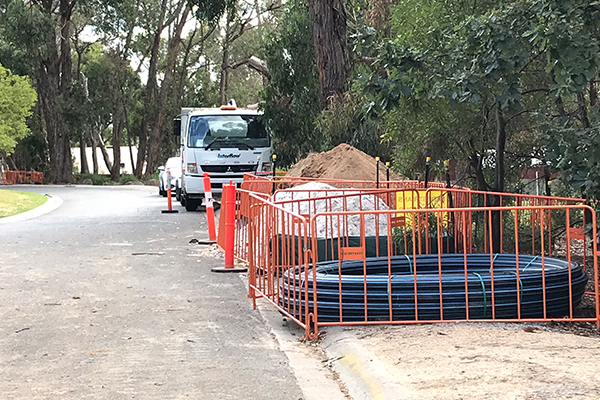
Water security comes in numerous forms, each as important as the last.
For some, the concept is all about malicious actions by hackers. This is well illustrated by a case study from Oldsmar, Florida, in 2021. A hacker compromised the systems of the local water treatment plant, attempting to dramatically increase levels of sodium hydroxide in the town’s potable water to potentially deadly levels.
For others, it’s about water efficiency, particularly around the prevention or minimisation of leaks in the system and the challenge of non-revenue water.
And for more, water security is more closely related to the resilience of our infrastructure and systems in the face of major weather events such as floods.
Of course, there are other definitions and understandings of water security. It is vital to recognise each as its own unique challenge, and to have specific solutions designed by water managers in consultation with experienced contractors.
The Water Services Association of Australia’s National Policy Position 2022 supports a new National Water Initiative, including a national water security framework for defining and measuring water security.
At the centre of most water security success, says John Weaver, Interflow’s Contracts Manager, is a well-maintained asset base.
“In the late 1970s and early 1980s there was a flurry of new sewer and water construction throughout Australia,” he says. “In the late 80s and early 90s, the sector moved away from new construction and towards asset management.”
“There was an increasing amount of old sewers and water lines that were leaking. Some of these assets were laid in the 1950s and 60s. The Environment Protection Authority’s focus was on stopping sewer leaks and overflows and maintaining the value of the assets.”
Legislation was introduced locking councils and water authorities in to coming up with long-term plans to maintain the value of their assets.
“That led to a lot relining work that Interflow did from the early 1990s, which is how we became deeply involved in water security,” Weaver says.
While maintenance will always be a core focus, the attention of water managers is also shifting towards ensuring water supply will not be affected by climate change.
“In other words, how do we take the stuff that falls from the sky, hold on to it and reuse it over and over again,” Weaver says.
“That’s the next phase of water security. How do we treat water as a very valuable resource, reusing and recycling it as much as we can, rather than discharging it after a single use?”
Recycling will play a major role in the water security solution in Australia, he believes. This has to do with reusing wastewater in the potable supply, as well as considering where wastewater is being sent.
Right now there is a great deal of discussion around treated water being reinjected into aquifers for storage, and then being reused, for example.
Western Australia has led the charge in this space, and replenishing groundwater with purified recycled water is now common practice in Perth.
Following suit, a water authority in Melbourne has conducted a tertiary treatment that created recycled water. When that water wasn’t being drawn upon, it was pumped into the ground, into the aquifer, to be recovered for future use.
Non-revenue water loss is a very big issue in Australia and globally. A report from Frost & Sullivan said almost one-third of all water, with a value of US$39 billion, is lost every year before it even reaches a customer.
In Australia, according to the Bureau of Meteorology, non-revenue water loss stands at around 10% of water utilities’ system input.
Of course, the more that networks reduce water loss, the less water we will require in the long run, Weaver says.
The combination of the reuse of water and the prevention of water loss could dramatically reduce the amount of water required in our systems.
And so, a large part of the solution lies in the network, Weaver says. How can the water network be optimised and operated with a program that identifies potential leaks before they actually occur?
That solution involves a mix of data-driven technology and proactive renewals programs.
As the case study from Florida highlighted, cybersecurity is a central concern for water managers.
At the same time, the cyber and technology issue goes a lot further than the protection of systems from those with bad intentions.
“Power and water security are deeply linked,” Weaver says. “If you don’t have power, you can’t pump water.”
This brings major weather events into play. Floods, for example, have proved to be far more efficient than hackers at knocking out power and damaging water supply systems.
“We need new options for when things go wrong,” he says.
“We need backup plans, and that’s probably the biggest challenge. This is also what a lot of people are discussing at AWA conferences. How do we make our systems disaster proof?”
Interflow’s role in water security right now is in collaborating with water authorities on their water and sewer renewals targets.
The organisation’s goal is to continue to improve the reliability and service life of water assets, meaning water authorities should be seeing less bursts and leaks, and instead conducting more proactive maintenance and renewal.
Interflow is working actively with water authorities, such as Yarra Valley Water, on a meter program to monitor exactly how much water goes in to and out of the network. This will support the water authorities in their understanding of where, how and why they’re losing water, enabling better asset management.
Essentially, Weaver says, it will enable water authorities to carry out work before problems reveal themselves.
The other major involvement Interflow has with water security comes through the simple fact that Interflow offers innovative solutions that often save the client money and other resources. These funds and resources can then be spent on further advancing the water security strategy.

On the Mountain Highway water main renewal project, for example, Interflow turned a $2 million job into a $1 million job by doing things differently and in a more innovative way. That money could then be spent elsewhere.
“A big part of the solution comes from innovation and better ways of doing things, which is what Interflow does best,” Weaver says. “When we’re part of the conversation from the beginning, we can often help release funds and resources into other areas, so water authorities can continue to improve.”